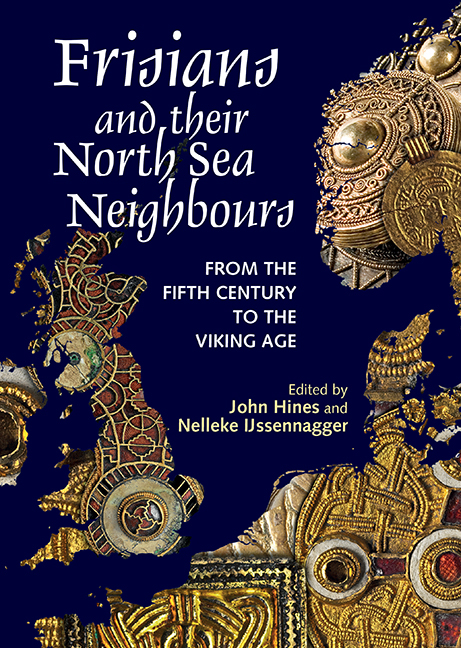Book contents
- Frontmatter
- Contents
- List of Figures
- List of Tables
- Preface
- Acknowledgements
- Linguistic Conventions and Abbreviations
- Abstracts
- Introduction: Frisians – Who, When, Where, Why?
- 1 Palaeogeography and People: Historical Frisians in an archaeological light
- 2 The Anglo-Frisian Question
- 3 Frisian between the Roman and the Early Medieval Periods: Language contact, Celts and Romans
- 4 ‘All quiet on the Western Front?’ The Western Netherlands and the ‘North Sea Culture’ in the Migration Period
- 5 Power and Identity in the Southern North Sea Area: The Migration and Merovingian Periods
- 6 How ‘English’ is the Early Frisian Runic Corpus? The evidence of sounds and forms
- 7 The Geography and Dialects of Old Saxon: River-basin communication networks and the distributional patterns of North Sea Germanic features in Old Saxon
- 8 Between Sievern and Gudendorf: Enclosed sites in the north-western Elbe–Weser triangle and their significance in respect of society, communication and migration during the Roman Iron Age and Migration Period
- 9 Cultural Convergence in a Maritime Context: Language and material culture as parallel phenomena in the early-medieval southern North Sea region
- 10 The Kingdom of East Anglia, Frisia and Continental Connections, c. ad 600–900
- 11 A Comparison of the Injury Tariffs in the Early Kentish and the Frisian Law Codes
- 12 Cultural Contacts between the Western Baltic, the North Sea Region and Scandinavia: Attributing runic finds to runic traditions and corpora of the Early Viking Age
- Index
10 - The Kingdom of East Anglia, Frisia and Continental Connections, c. ad 600–900
Published online by Cambridge University Press: 25 August 2018
- Frontmatter
- Contents
- List of Figures
- List of Tables
- Preface
- Acknowledgements
- Linguistic Conventions and Abbreviations
- Abstracts
- Introduction: Frisians – Who, When, Where, Why?
- 1 Palaeogeography and People: Historical Frisians in an archaeological light
- 2 The Anglo-Frisian Question
- 3 Frisian between the Roman and the Early Medieval Periods: Language contact, Celts and Romans
- 4 ‘All quiet on the Western Front?’ The Western Netherlands and the ‘North Sea Culture’ in the Migration Period
- 5 Power and Identity in the Southern North Sea Area: The Migration and Merovingian Periods
- 6 How ‘English’ is the Early Frisian Runic Corpus? The evidence of sounds and forms
- 7 The Geography and Dialects of Old Saxon: River-basin communication networks and the distributional patterns of North Sea Germanic features in Old Saxon
- 8 Between Sievern and Gudendorf: Enclosed sites in the north-western Elbe–Weser triangle and their significance in respect of society, communication and migration during the Roman Iron Age and Migration Period
- 9 Cultural Convergence in a Maritime Context: Language and material culture as parallel phenomena in the early-medieval southern North Sea region
- 10 The Kingdom of East Anglia, Frisia and Continental Connections, c. ad 600–900
- 11 A Comparison of the Injury Tariffs in the Early Kentish and the Frisian Law Codes
- 12 Cultural Contacts between the Western Baltic, the North Sea Region and Scandinavia: Attributing runic finds to runic traditions and corpora of the Early Viking Age
- Index
Summary
East Anglia has long been appreciated as sharing links with the Continent, and the Netherlands in particular, through its geographical position on the North Sea littoral. While the sea has always acted as a conduit between the two areas, the extent and duration of particular phases of contact has been more difficult to assess. The question is particularly interesting in the case of Frisia, as linguistic similarities have suggested a close relationship with England. Likewise, the Netherlands coastal regions appear to have had limited settlement, suggesting the movement of peoples from the Anglo-Saxon west (Bremmer 1990; Knol 2009; Nieuwhof 2013). In this paper I examine the nature of these contacts following the Migration Period of the 5th and 6th centuries and before the opening of the Viking Age.
I use the kingdom of East Anglia as the basis of study for two reasons. First, as a defined political, geographical and possibly cultural entity in the Anglo-Saxon period, it provides us with a unit that maintained its integrity at a number of levels throughout this period. Second, and perhaps most pertinent, it is the obvious place to look for evidence of cultural interaction, being the political and topographical land unit within England geographically closest to early-medieval Frisia (Fig. 10.1). In its Anglo-Saxon sense, East Anglia may broadly be defined as the modern English counties of Norfolk and Suffolk, although as Bede makes clear, the Isle of Ely was certainly included within it in the late 7th century at least (Historia Ecclesiastica IV.19). Surrounded by sea to the north and east, and partially isolated by the extensive marshlands of the Fens to the west, only to the south, and the border with the kingdom of the East Saxons, was there more traversable countryside. With its long coastline and rivers draining into the North Sea, East Anglia was a kingdom particularly suited to maritime communication, and an almost island-like territory itself on England's east coast.
Historical background
It seems right to discuss the sources that chronicle the historical kingdom's relations with the Continent first. Sadly, these are limited, reflecting the paucity of documentation for East Anglia more generally.
- Type
- Chapter
- Information
- Frisians and their North Sea NeighboursFrom the Fifth Century to the Viking Age, pp. 193 - 222Publisher: Boydell & BrewerPrint publication year: 2017



